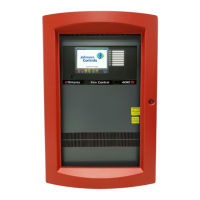page 19 579-1150 Rev M
4010ES IDNAC Fire Alarm System Installation Guide
3.3.3 Specifications
Table 14 lists the specifications for the ESS.
Table 14: Input and output specifications
Operating conditions
32
o
F to 120
o
F (0
o
C to 49
o
C)
Up to 93% relative humidity at 90
o
F (32
o
C), non-condensing.
AC input specifications
ESS in 120V FACU
4A maximum,
120VAC @ 60Hz, nominal
ESS in 220/240V FACU
2A maximum,
220/230/240VAC @ 50 or 60Hz
The ESS detects a low or missing AC input and switches to batteries automatically. The system returns to AC when it has detected the
presence of acceptable AC levels for a minimum of 30 seconds. AC wiring has to run from a dedicated AC branch circuit and the breaker/
wiring sized according to local codes.
DC output specifications
IDNAC SLC 29.5 VDC 3A per circuit, 6 A total*
AUX power/simple NAC
Minimum: 19.9VDC (special applications)
Maximum: 31.1VDC
Ripple: 2VDC p-p @ full load (2A)
IDNet output 30V or 35V**
Note: *Any current consumed by other sources beyond the ESS, CPU, and display (AUX/simple NAC, card power, sig power, etc.) subtracts
from available IDNAC current. See Table 15.
Note: **When a large numbers of output devices are activated on IDNet peripherals (such as piezo sounders), the output voltage is
increased to 35V to provide sufficient voltage at the end of line to activate the piezo. The higher voltage state is an alarm condition for the
purpose of standby battery calculation. The 30V output is the normal condition and is used to prolong battery standby. The CPU will acti-
vate the boost feature when 10 LED, piezo or other outputs are activated.
Battery charger specifications
Input voltage range 21-33VDC
Output float voltage
27.4VDC @ 20
o
C, temperature compensated at
-24 mV/
o
C
High voltage output 29.1V @ 3.3A
Output current limit
1.65A (for 6.2 - 18Ah battery)
3.3A (default; for 18-50Ah battery- Canadian; for 18-110Ah battery - U.S.)
The battery circuit is supervised for low battery and missing/depleted battery.
Table 15 lists the relationship between current consumed by sources beyond the ESS, CPU and display, and the available total IDNAC
current.
Table 15: Total IDNAC current vs other current
Other current Available Total IDNAC current
0.25 A 5.81 A
0.5 A 5.63 A
0.75 A 5.44 A
1 A 5.25 A
1.5 A 4.88 A
2 A 4.50 A
3 A 3.75 A
5 A 2.25 A
Table 16 lists the battery current draw for the ESS. The assumed voltage is 24VDC, which is rated battery voltage for lead-acid type
batteries.
Table 16: ESS current specifications
Standby conditions* Current (battery 24V)
No alarms (NACs normal); IDNet LED on, no IDNet devices connected 160mA
Add to base for each additional set of 50 IDNet devices in standby 40 mA
Add to base for each additional set of 50 IDNAC appliances in standby 40 mA

